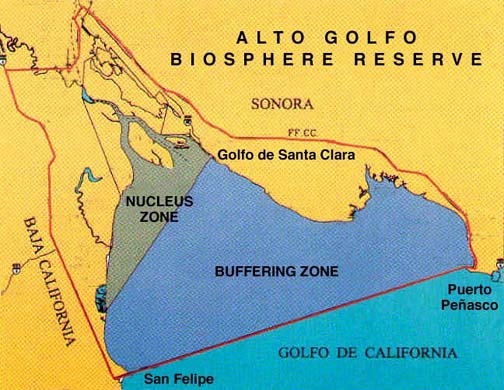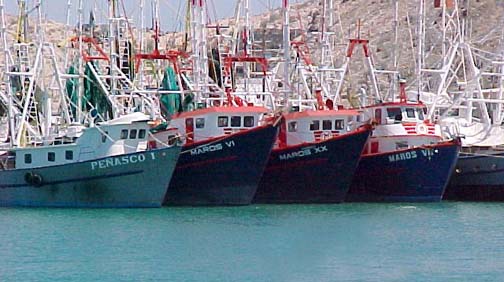
Law at Alto Golfo
![]()
|
Mexico's Alto Golfo Biosphere Reserve at the north end of the Sea of Cortez. |
FISHERIES REGULATION ENFORCEMENT AT MEXICO'S
PROTECTED ALTO GOLFO BIOSPHERE RESERVE
By Gene Kira, Nov. 4, 2002, as published in Western Outdoor News:
"Who owns Mexico's fish?"
That fundamental question may be decided for future generations in a watershed battle now unfolding in the Alto Golfo Biosphere Reserve at the extreme north end of the Sea of Cortez.
Historically, Mexico's sea life has been treated as the de facto property of commercial fishing interests, as sanctioned by the Department of Fisheries (CONAPESCA), and as represented in the Alto Golfo by a large fleet of shrimp boats averaging about 700 pangas and about 350 trawlers.
Locally, these boats are based at San Felipe, El Golfo de Santa Clara, and Puerto Peñasco (Rocky Point), and further down the coast, they are found mainly at Guaymas, Yavaros, Topolobampo, and Mazatlan.
|
|
For generations, these fleets have trawled and netted for shrimp in the shallow waters surrounding the Colorado River Delta, and even inside the Alto Golfo Biosphere Reserve which was protected in 1993. Despite the presence of two endemic endangered species (vaquita dolphin and totoaba) and laws protecting the area of the Biosphere Reserve dating back as far as 1955, the shrimp industry gradually lost control of itself. The unrestrained, go-for-broke attitude of the Department of Fisheries resulted in disastrous overfishing, disruption of the fragile sea bottom, and an incidental "by-catch" rate of about 95 percent. The entire Alto Golfo fishery, even including the fantastic original shrimp population, became an economic and biological wasteland.
No más.
Only two years after the election of President Fox--and his choice of Victor Lichtinger as his Secretary of Natural Resources--a new vision is emerging that sees Mexico's fish as a national patrimony, owned not by the fishermen, but by the population at large. For the first time, fishing is being seen not as an inherent right, but as a privilege granted by all the people of Mexico, to be exercised only on the condition that the resource is respected and preserved for future generations.
Citing environmental concerns, Secretary Lichtinger's Department of Natural Resources published an emergency regulation on September 23 that immediately shut down the entire trawler fleet inside the Alto Golfo Biosphere Reserve. This unprecedented, and not entirely justifiable, action was backed up with massive force: 40 inspectors sent by PROFEPA's Attorney General Jose Campillo, four Navy ships, two Navy interceptor boats, a Navy helicopter, a twin-engine Navy hydroplane, eight PROFEPA 400-horsepower super pangas, and the whole thing led personally by Mexico's top marine enforcement official, the extremely tough Luis Fueyo from Mexico City.
Stunned and confused, the commercial shrimping industry, led by its national trade organization, CANAINPESCA, sent a letter of protest, and mounted a rather feckless 30-hour road blockade at Puerto Peñasco on October 19-20.
With suspicious speed and ease, the road blockaders were rewarded on October 20 with an instant agreement from Secretary Lichtinger that allowed trawlers--but only local trawlers--to resume fishing inside the Buffering Zone of the Biosphere Reserve. The Secretary's clever strategy became apparent. By imposing a draconian total closure of the entire Biosphere Reserve, even though some local boats were legally entitled to fish in parts of it, he had split the CANAINPESCA lobby into halves and broken its power.
To save their own bacon, the local trawlers from San Felipe and Puerto Peñasco broke free from CANAINPESCA and agreed to Secretary Lichtinger's terms. The extremely powerful southern bloc, centered in Guaymas and Mazatlan, was left twisting in the wind. For the first time ever, law came to the Alto Golfo.
What did Secretary Lichtinger win?
In a series of historic working agreements actually reached over a period of time, here are some key elements of the new status quo:
|
|
--All boats not belonging to local residents of San Felipe, El Golfo de Santa Clara, or Puerto Peñasco are banned. Pangas are reduced in number from about 700 to about 350. Trawlers are reduced from about 350 to 130.
--The shrimp season is limited to the months of October, November, and December.
--By-catch is limited to 50 percent.
--The by-catch tolerance for endangered species is zero.
--All pangas have agreed to shorten nets from as long as 2,000 meters to no more than 700 meters. Only one net is allowed, not two. Motors are limited to 75 horsepower.
--No shrimp fishing will occur within three miles of shore, or within three miles of Roca Consag.
--All trawler nets are reduced to 100 feet in width, and are required to have a turtle excluder, a juvenile fish excluder, and an adult fish excluder, all certified as effective by PROFEPA.
--And most critically, all remaining fleets have agreed that either PROFEPA inspectors or honest on-board observers will be allowed to monitor their activities.
In many ways, the Alto Golfo experience may be viewed as a microcosm of Mexico's fisheries problems in general, and PROFEPA's recent actions as a blueprint for what needs to be done everywhere.
During the past year, Mexico has made startlingly swift, revolutionary progress on sustainable fisheries management. With longlines recently banned by the U.S. to its north, sailfish about to be totally protected by Guatemala to its south, a butt-kicking Secretary of Natural Resources, and a new attitude about who owns the fish, Mexico's moment in the sun seems to be arriving at last.
|
Shrimp trawlers at Puerto Peñasco, Mexico. |
(Related Mexico articles and reports may be found at Mexfish.com's main Mexico information page. See weekly fishing news, photos, and reports from the major sportfishing vacation areas of Mexico including the Mexico area in "Mexico Fishing News.")
MEXICO FISHING INFO MEXICO FISHING INFO "WEEKLY MEXICO FISHING NEWS" FISH PHOTO GALLERY

